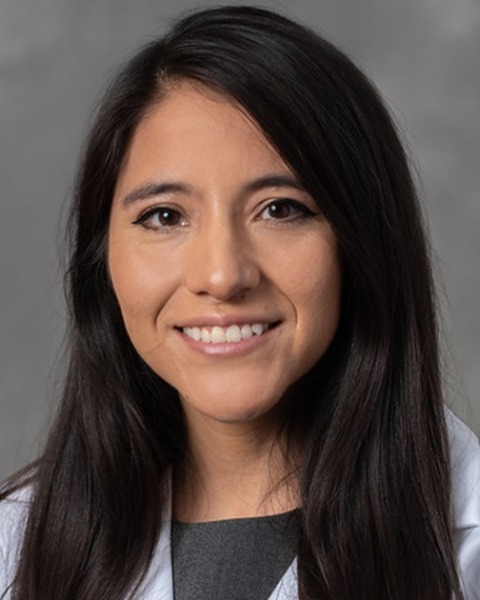ACOS 2024 Annual Clinical Assembly
General Surgery
Incidental finding of PTEN De Novo Mutation in Breast Cancer: A Case Report

Jennifer Orellana, DO
Resident
Henry Ford Macomb
Primary Presenter(s)
Cowden Syndrome (CS), also referred to as multiple hamartoma syndrome or PTEN hamartoma tumor syndrome, it is a multisystem condition caused by pathogenic variants (PV’s) within the PTEN tumor suppressor gene. PV’s in this gene can lead to uncontrolled cell proliferation, causing multisystem benign neoplasms and malignancies. (figures 1 and 2) PV’s in PTEN are associated with a variety of lesions occurring most often in the skin, mucous membranes, breast, thyroid, endometrium and brain. Individuals with Cowden syndrome are also more likely to develop bilateral and multifocal cancer2.
This condition is rare with an estimated prevalence of 1 in 200,000 people. CS is most frequently inherited in an autosomal dominant fashion but arises as a spontaneous or de novo PV’s in up to 40% of cases3. The clinical features usually start to present in the second and third decade of life with the average age of diagnosis at 39 years. Given that the expressivity of CS can be variable there are other criteria used to clinically diagnosis CS besides genetic testing. Major and minor criteria have been set that represent phenotypical characteristics and diseases of CS. Minor criteria include; genitourinary tumors or malformations, lipomas, fibromas, mental retardation, fibrocystic disease of the breast, gastrointestinal hamartomas, and other thyroid lesions, such as goiter. Major criteria include; thyroid carcinoma, macrocephaly, breast cancer, and Lhermitte-Duclos disease – a rare dysplastic gangliocytoma of the cerebellum. (Table 1) An individual meets the clinical criteria for a CS diagnosis if at least one of the following is present: adult Lhermitte-Duclos Disease or a requisite number of mucocutaneous features, macrocephaly plus one other major criterion, one major and three minor criteria, or four minor criteria3. We present a case of a young female found to have a denovo PTEN PV and diagnosed with Cowden Disease and her unique breast cancer presentation. AJ is a 37 year old female who presented to the ED on 4/2/23 with complaint of chest tightness, left shoulder pain and shortness of breath. ED workup included; positive D-dimer and CT PE protocol was significant for bilateral multilobular PE and mild increase of soft tissue within the left breast. Of note, this patient has a past medical history of Hashimoto’s thyroiditis with total thyroidectomy, multiple skin lesion/masses that have been removed, and endometriosis. No prior personal history of cancer and only a family history of prostate cancer in her father. Her hospital course was uncomplicated and she started on Eliquis. She underwent further outpatient evaluation for breast evaluation with diagnostic mammogram and US for the left breast density seen originally on the CT PE scan. This showed innumerable left breast masses, but two main areas of concern.(figure 3) She then underwent US biopsy of both locations, pathology showed microinvasive ductal carcinoma, grade 1, ER/PR (+), HER2(-). She had an evaluation by the breast surgeon and her clinical anatomic stage was noted to be: Stage 1 (T1aN0M0) clinical prognostic stage 1A. Given her young age she was referred to a genetic counselor for evaluation. Her genetic testing was positive for a pathogenic PTEN gene variant, a diagnosis of Cowden syndrome was made. Her parents were also brought in for testing, but both found to be negative for PTEN mutation.(figure 4) Paternity was validated, thus making this a denovo pathogenic PTEN mutation found in this patient. Given this patient’s increased risk for breast cancer, she elected to undergo bilateral mastectomy with reconstruction. She also will undergo a hysterectomy and bilateral salpingo-oopherectomy. Our patient not only was identified to carry a pathogenic PTEN variant, but also met the major criteria for CS. Her head circumference was measured to be greater than the 97th percentile for females along with her new diagnosis of breast cancer. However, she also had a history of thyroid disease with thyroidectomy and multiple skin lipomas/masses that were removed. The lifetime risk of developing breast cancer, in patients with CS, is 85%, with an average age of diagnosis between 38 and 46 years4. When discussing treatment options for these women it is important to mention these high rates of cancer and to discuss prophylactic treatments with hysterectomy and bilateral mastectomy. All individuals with CS should have an annual comprehensive physical exam starting at age 18 years or 5 years before the youngest age of diagnosis of a component cancer in the family, whichever comes first. Breast cancer is the most common malignancy of CS, due to this, high risk screening is offered to these women. This includes annual mammography and breast MRI, along with genetic counselling and education5. Imaging screening is to start at age 35, or 10 years prior to earliest known family breast cancer diagnosis, but not before age 25, and physical breast exams to begin at age 255. Although Cowden Syndrome is a rare disease, there are other physical manifestations associated with it. The physician needs to have a high index of suspicion as these patients are at increased risk for early thyroid, breast, colon and renal cancers and need closer monitoring and discussions of possible prophylactic treatments.
Methods or Case Description:
Outcomes:
Conclusion: Learning Objectives:
